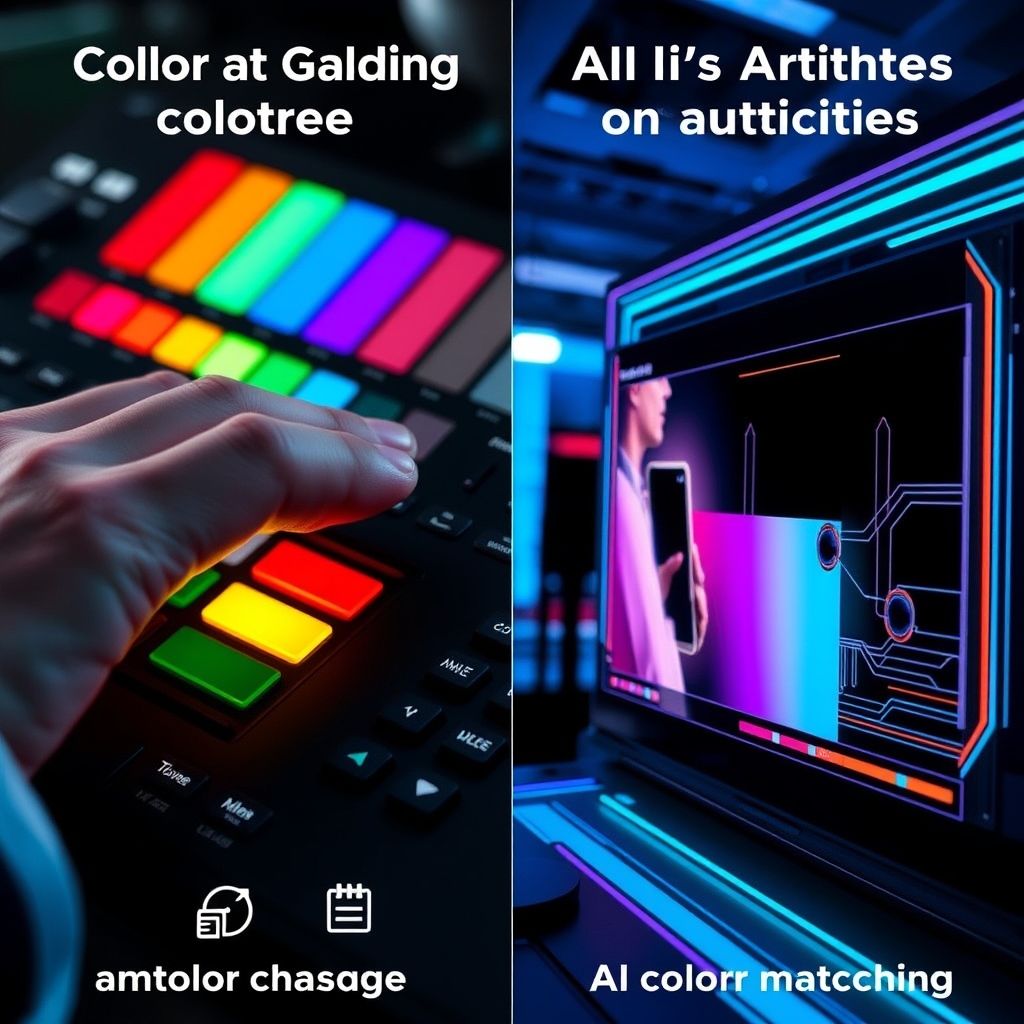The Great Color War: Machines vs. Humans
Color. It’s what separates a passable image from something that screams ‘professional.’ Whether you’re crafting the next blockbuster or just trying to make your cat videos less… beige, color grading is key. But the age-old question remains: should you trust your eyes, or the cold, unfeeling logic of a machine?
Round 1: Manual Color Matching – The Old Guard
Imagine a grizzled veteran, squinting at a monitor, tweaking knobs with the precision of a brain surgeon. That’s manual color matching. It’s the art of painstakingly adjusting hues, saturation, and luminance until your footage looks just right. Think Photoshop, but for moving pictures.
Pros:
- Creative Control: You’re the boss. Every decision, every nuance, is yours. Want a slightly warmer tone? Go for it. Feeling a bit… teal today? No one’s stopping you (except maybe your audience).
- Artistic Expression: It’s an art, dammit! You’re not just matching colors; you’re crafting a mood, telling a story. Machines can’t feel the existential dread of a Tuesday afternoon (yet).
- Precision: When done right, manual grading offers unparalleled precision. You can target specific areas, fix tiny imperfections, and generally make things look amazing.
Cons:
- Time-Consuming: Forget instant gratification. This is a marathon, not a sprint. Expect to spend hours, possibly days, tweaking colors. Hope you like staring at a screen.
- Requires Expertise: You can’t just jump in and become a color guru overnight. It takes training, experience, and a good eye (or maybe just really expensive glasses).
- Subjectivity: What looks good to you might look terrible to someone else. Prepare for feedback, and maybe a few existential crises.
Round 2: AI Color Matching – The New Contender
Enter the robots. AI color matching promises to automate the tedious parts of color grading, using algorithms to analyze and adjust colors in a fraction of the time. Think of it as the self-driving car of video editing. Hopefully, it won’t drive off a cliff.
Pros:
- Speed: This is where AI shines. It can analyze and match colors across multiple clips in seconds. Perfect for those all-nighters when you’re fueled by caffeine and regret.
- Consistency: No more variations between scenes. AI ensures that your colors remain consistent throughout your entire project. Finally, a little stability in this chaotic world.
- Efficiency: Great for large projects with tons of footage. Let the AI handle the grunt work while you focus on the creative stuff… like brainstorming witty captions.
Cons:
- Lack of Artistic Intuition: AI can match colors, but it can’t feel them. It lacks the human element, the ability to understand the emotional impact of color.
- Limited Customization: While AI is getting better, it still offers less flexibility than manual grading. You’re stuck with the algorithm’s choices, whether you like them or not.
- Potential for Generic Looks: If everyone uses the same AI tools, everything starts to look… the same. Prepare for a world of homogenous, algorithmically-approved visuals. Great.
The Verdict: It Depends (Of Course)
So, who wins? The truth is, there’s no clear winner. The best approach depends on your specific needs and priorities.
Choose Manual If:
- You need precise control over every aspect of your colors.
- You want to express your artistic vision.
- You have the time and expertise to do it right.
Choose AI If:
- You need to grade a large amount of footage quickly.
- You want consistent results across multiple clips.
- You’re a beginner or don’t have a lot of time to learn manual grading.
Wondershare Filmora: A Possible Truce?
Tools like Wondershare Filmora offer a hybrid approach, combining the speed of AI with the flexibility of manual adjustments. Filmora’s color matching feature aims to bring a perfect color balance with minimal effort. Think of it as a peace treaty between man and machine. Okay, maybe that’s overstating it.
**Here’s a quick rundown of using Filmora’s AI Color Match (because who reads manuals anyway?):
**
- Download and Install: Get Filmora from their official website. (You can probably figure this out).
- Import Footage: Drag your reference video and the video you want to adjust into Filmora.
- Apply the Magic: Select your reference video, go to Color > Basic > AI Color Palette, and click Add.
- Generate and Apply: Follow the prompts to select a reference frame and generate the color match.
- Tweak and Export: Adjust the Strength and Protect Skin Tones settings, then export your masterpiece.
The Future of Color
The color grading landscape is constantly evolving. AI is getting smarter, and manual techniques are becoming more refined. The key is to stay informed, experiment with different tools, and find what works best for you. And remember, even if the robots do take over, there will always be a need for human creativity… right?
Now, if you’ll excuse me, I’m going to go stare at a color wheel and contemplate the meaning of existence. Or maybe just watch cat videos. You decide.



Leave a Reply